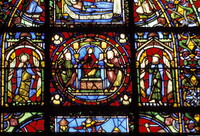Saint-Denis: Stained Glass in Chevet and Ambulatory
Suger, Abbot of Saint-Denis

Download1A2-F-P-SD-5-C3_cp.jpg (659.6Kb)
Date
1140-1850Description
Chapel of the Virgin, Life of the Virgin (Infancy of Christ), detail of window, northern bay; Little remains of the abbey's important and influential medieval glazing. The windows of the Rayonnant choir and nave, probably the most important 13th-century ensemble in the Paris region before the glazing of the Sainte-Chapelle, were destroyed in the Revolution. They are documented only in a sketch, one of a series (Compiègne, Mus. Mun. Vivenel) made in 1794-1795 by Charles Percier, and the reliability of even this has been challenged (Lillich). Despite the effects of the Revolution and a series of 19th-century restorations, more glass, and better documentation, survive from the ambulatory of Suger's 12th-century church, enabling some evaluation of the significance of this glazing within the history of medieval art. Glazing played an unprecedentedly influential role in the design of Suger's church, especially in the ambulatory. Here for the first time stained glass became an important feature, perhaps the most important feature, of an architectural environment. In Suger's record of his administration, some of his most rhapsodic commentary praises the pervasiveness of coloured light in the building. He describes the manner in which the choir shone 'with the wonderful and uninterrupted light of most sacred windows, pervading the interior beauty' (Panofsky, p. 101). Suger admired the windows not principally for their beauty but for the way in which their luminosity could help the viewer to approach God through the contemplation of light. Source: Grove Art Online; http://www.groveart.com/ (accessed 2/3/2008)
Type of Work
stained glass (visual work)Subject
cycles or series, decorative arts, New Testament, Old Testament and Apocrypha, Gothic (Medieval), Nineteenth century
Rights
Rights Statement
Licensed for educational and research use by the MIT community only